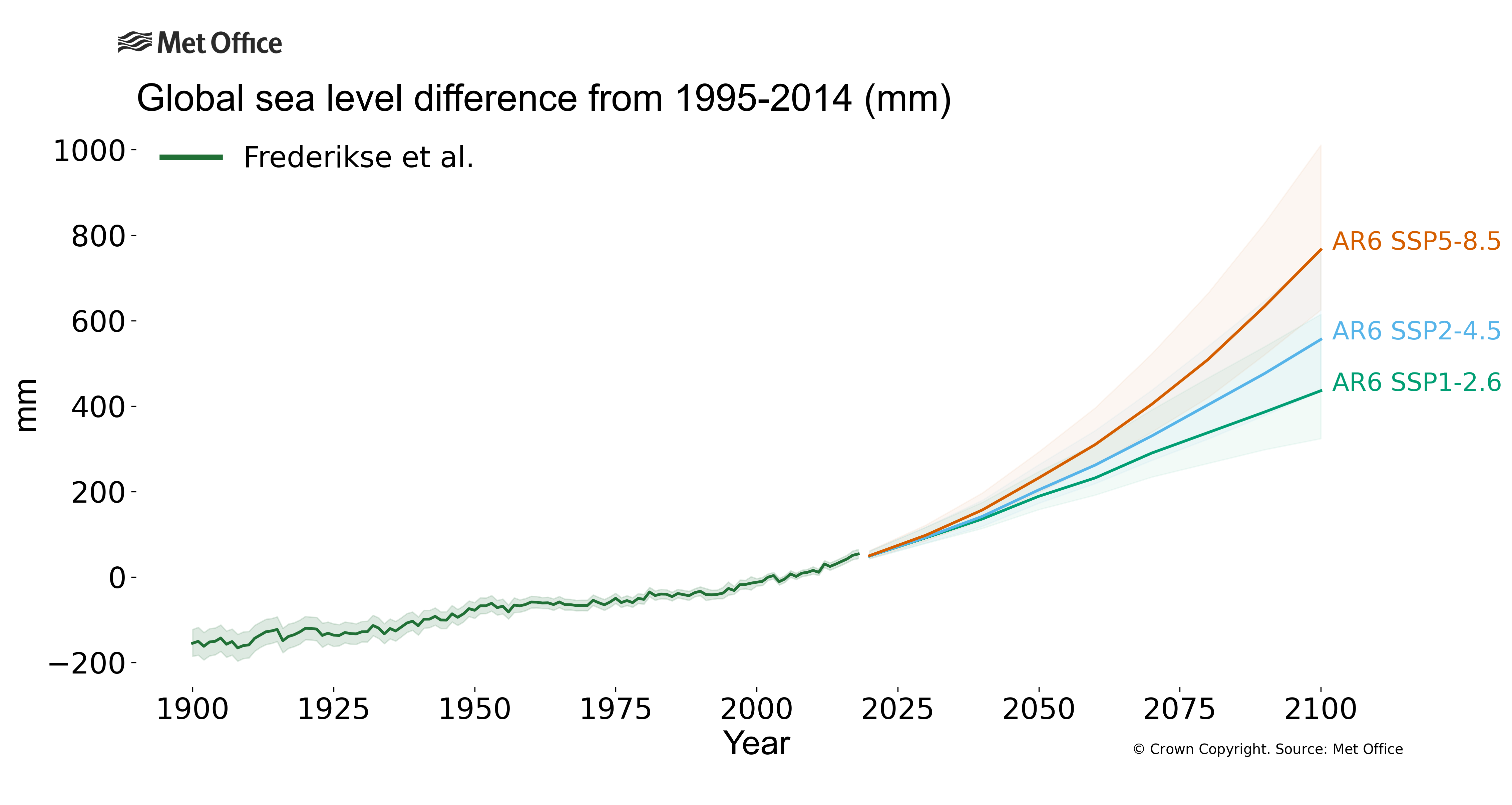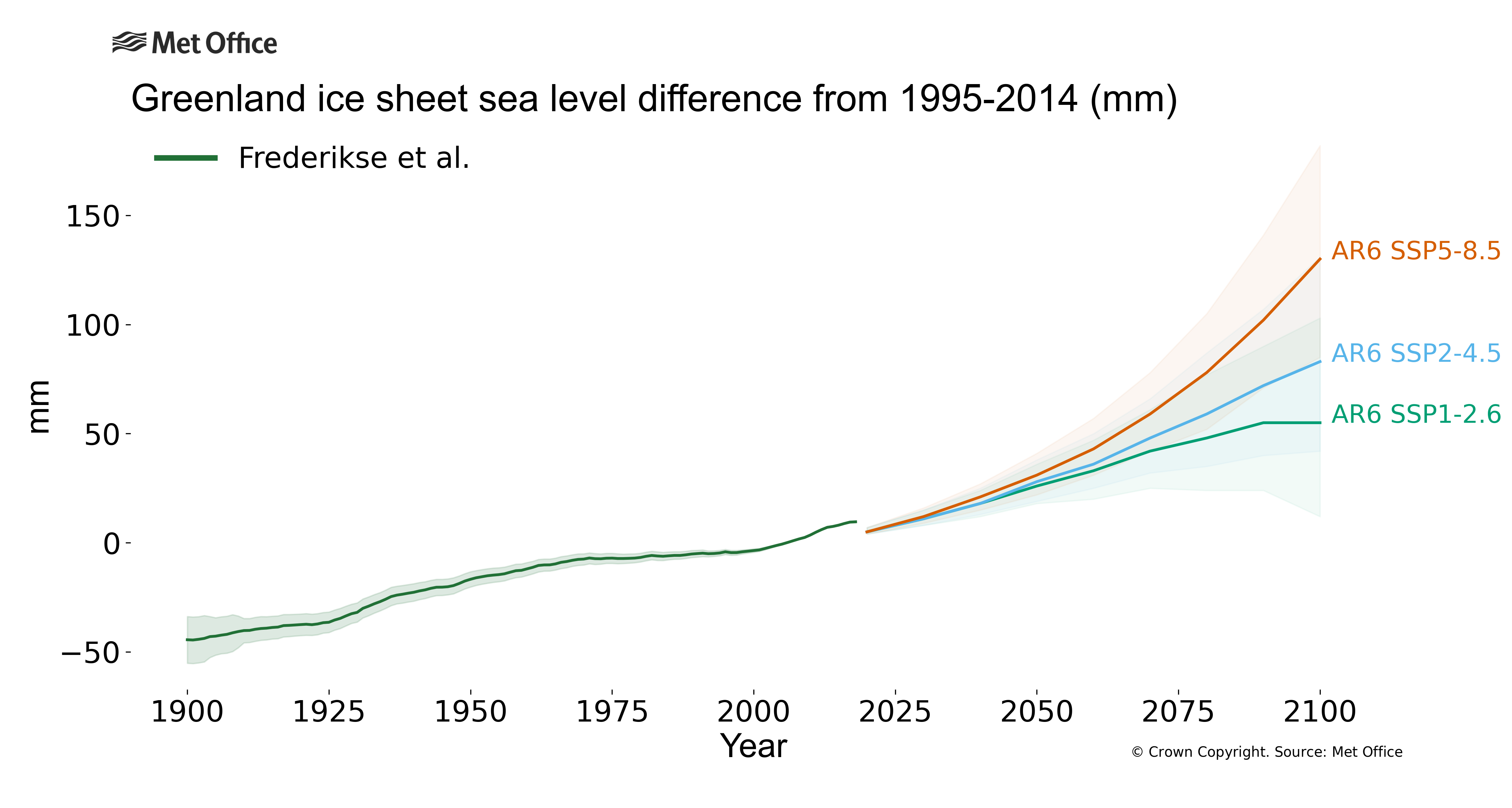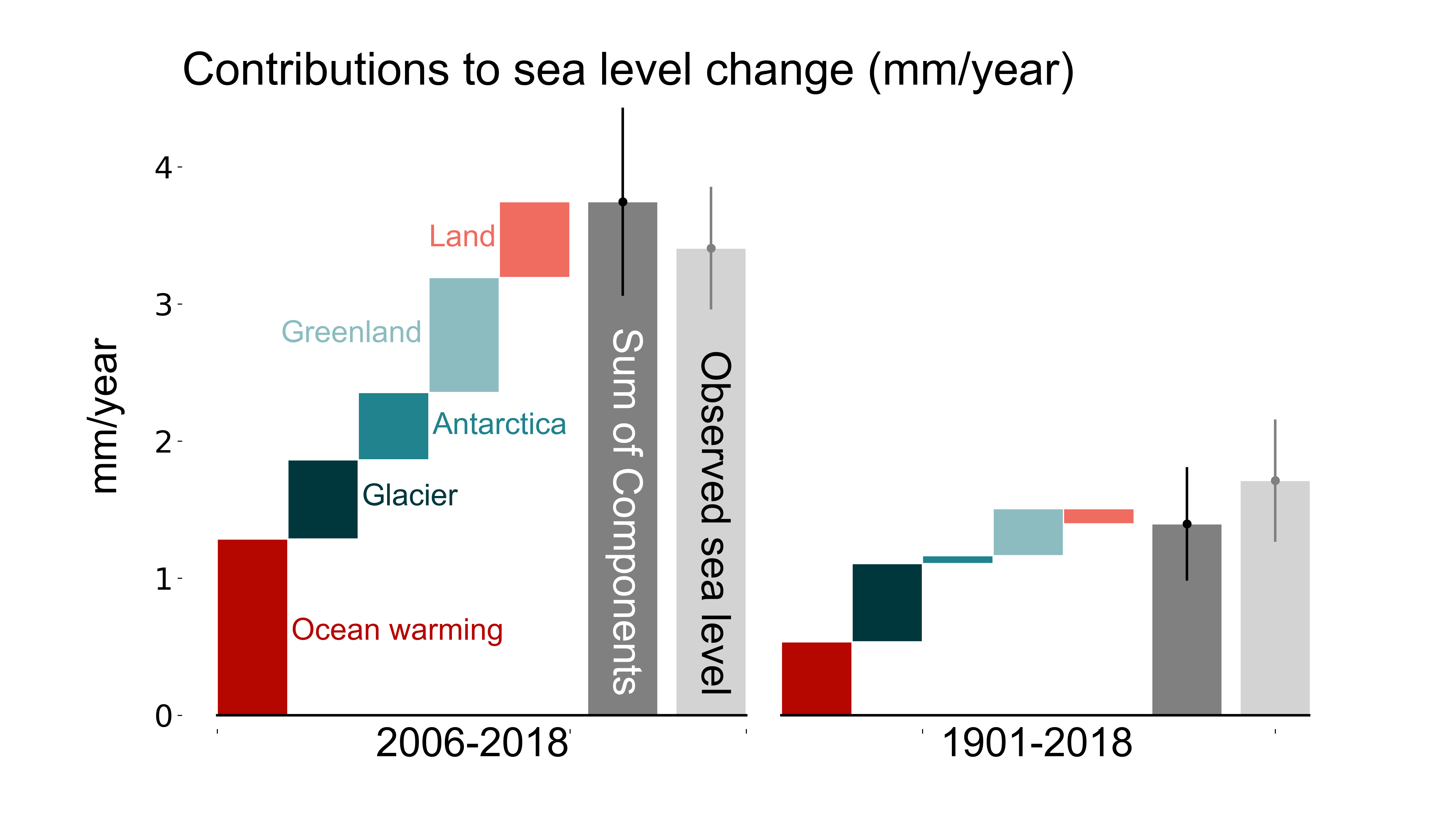Why is the Greenland Ice Sheet important for understanding sea level change?
Melt from the Greenland ice sheet has contributed to the increase in sea levels during the past century and, as one of the world’s largest freshwater reservoirs, how the Greenland Ice sheet changes in the future is crucial to our climate change planning. If it were to be lost entirely it could contribute 7m to global mean sea level rise over several thousand years.
How has the Greenland Ice Sheet changed?
The IPCC states that the Greenland Ice Sheet has lost 4890Gt mass over the period 1992–2020, which is equivalent to 13.5mm of global mean sea level rise. The mass loss rate has increased six-fold in recent decades, being 39Gt/yr between 1992 and 1999 and 243Gt/yr between 2010 and 2019 on average. 362.5Gt of ice is approximately equivalent to 1mm of global mean sea level rise. A number of observational products (including GRACE, PROMICE, ESA-CCI and MEaSUREs) are now available that have tracked the shrinking of the Greenland ice sheet over the past decades.
Why has the Greenland Ice Sheet changed?
The Greenland ice sheet has lost mass in recent decades from both ice discharge and ice melting from the surface of the ice sheet. The loss from melt has exceeded the gain from snow and rainfall, although this relationship varies from year to year. The IPCC states that “It is very likely that human influence has contributed to the observed surface melting of the Greenland Ice Sheet over the past two decades”.
How is the Greenland Ice Sheet projected to change in the future?
There is projected to be further ice melt from the Greenland ice sheet throughout the 21st century regardless of scenario, with total mass loss projected to be higher under higher emissions scenarios. At sustained global warming of between 2 and 3°C above pre-industrial conditions there is limited evidence that the Greenland Ice Sheet will be lost almost entirely over the next few thousand years.
How is the Greenland Ice Sheet measured?
The contribution of the Greenland Ice Sheet to sea level change used here comes from Frederikse et al., 2020. From 1900 to 1972 the mass loss rate comes from a reconstruction based on knowledge of the ice sheet edge in 1900, taken as the end of the ‘Little Ice Age’, and aerial photographs taken in the late 1970s and early 1980s (Kjelsden et al., 2015).
From 1972 to 1993 this information is combined with estimates produced by Mouginot et al., 2019, who assess the Greenland mass balance by comparing its calculated ice discharge with the expected snow fall accumulation from climate models.
From 1993 to 2003 these estimates are further combined with the work of Bamber et al., 2018, which compares estimates based primarily on literature published since AR5 (2013) along with expert judgement, new analyses, and statistical models.
After 2003, satellite observations from the GRACE missions, which observe redistribution of mass over the Earth’s surface by measuring changes in the Earth gravity field, were used to calculate the Greenland Ice Sheet contribution
How are the Greenland Ice Sheet projections made?
Simulations of the Greenland Ice Sheet from the ISMIP6 ice sheet multi-model intercomparison project were used as inputs to simple models known as "emulators" to provide a set of projections across scenarios that are consistent with the underlying science assessment of AR6. Beyond 2100, the projections are extended using emulators based on either a constant rate of mass loss or the AR6 assessment at 2300. Structured expert judgement was also used as an estimate of the "low likelihood, high impact" possibility of rapid mass loss.
Find out more?
References
AR6 Projections
- Information source: Fox-Kemper, B., H. T. Hewitt, C. Xiao, G. Aðalgeirsdóttir, S. S. Drijfhout, T. L. Edwards, N. R. Golledge, M. Hemer, R. E. Kopp, G. Krinner, A. Mix, D. Notz, S. Nowicki, I. S. Nurhati, L. Ruiz, J-B. Sallée, A. B. A. Slangen, Y. Yu, 2021, Ocean, Cryosphere and Sea Level Change. In: Climate Change 2021: The Physical Science Basis. Contribution of Working Group I to the Sixth Assessment Report of the Intergovernmental Panel on Climate Change [Masson-Delmotte, V., P. Zhai, A. Pirani, S. L. Connors, C. Péan, S. Berger, N. Caud, Y. Chen, L. Goldfarb, M. I. Gomis, M. Huang, K. Leitzell, E. Lonnoy, J. B. R. Matthews, T. K. Maycock, T. Waterfield, O. Yelekçi, R. Yu and B. Zhou (eds.)]. Cambridge University Press. In press.
- Information source: Garner, G. G., R. E. Kopp, T. Hermans, A. B. A. Slangen, G. Koubbe, M. Turilli, S. Jha, T. L. Edwards, A. Levermann, S. Nowikci, M. D. Palmer, C. Smith, in prep. Framework for Assessing Changes To Sea-level (FACTS). Geoscientific Model Development.
- Information source: Garner, G. G., T. Hermans, R. E. Kopp, A. B. A. Slangen, T. L. Edwards, A. Levermann, S. Nowikci, M. D. Palmer, C. Smith, B. Fox-Kemper, H. T. Hewitt, C. Xiao, G. Aðalgeirsdóttir, S. S. Drijfhout, T. L. Edwards, N. R. Golledge, M. Hemer, R. E. Kopp, G. Krinner, A. Mix, D. Notz, S. Nowicki, I. S. Nurhati, L. Ruiz, J-B. Sallée, Y. Yu, L. Hua, T. Palmer, B. Pearson, 2021. IPCC AR6 Sea-Level Rise Projections. Version 20210809. PO.DAAC, CA, USA. Dataset accessed [YYYY-MM-DD] at https://podaac.jpl.nasa.gov/announcements/2021-08-09-Sea-level-projections-from-the-IPCC-6th-Assessment-Report.
- Information reference: We thank the projection authors for developing and making the sea-level rise projections available, multiple funding agencies for supporting the development of the projections, and the NASA Sea-Level Change Team for developing and hosting the IPCC AR6 Sea-Level Projection Tool. We also acknowledge the World Climate Research Programme, which, through its Working Group on Coupled Modelling, coordinated and promoted CMIP6. We thank the climate modeling groups for producing and making available their model output, the Earth System Grid Federation (ESGF) for archiving the data and providing access, and the multiple funding agencies who support CMIP6 and ESGF.
Greenland Contribution
AR6 SSP1-2.6
AR6 SSP2-4.5
AR6 SSP5-8.5
Frederikse et al.
- Information source: Frederikse, T., Landerer, F., Caron, L. et al. The causes of sea-level rise since 1900. Nature 584, 393–397 (2020). https://doi.org/10.1038/s41586-020-2591-3
- Information reference: Thomas Frederikse, Felix Landerer, Lambert Caron, Surendra Adhikari, David Parkes, Vincent W. Humphrey... Yun-Hao Wu. (2020). data supplement of 'The causes of sea-level rise since 1900' [Data set]. Zenodo. http://doi.org/10.5281/zenodo.3862995


